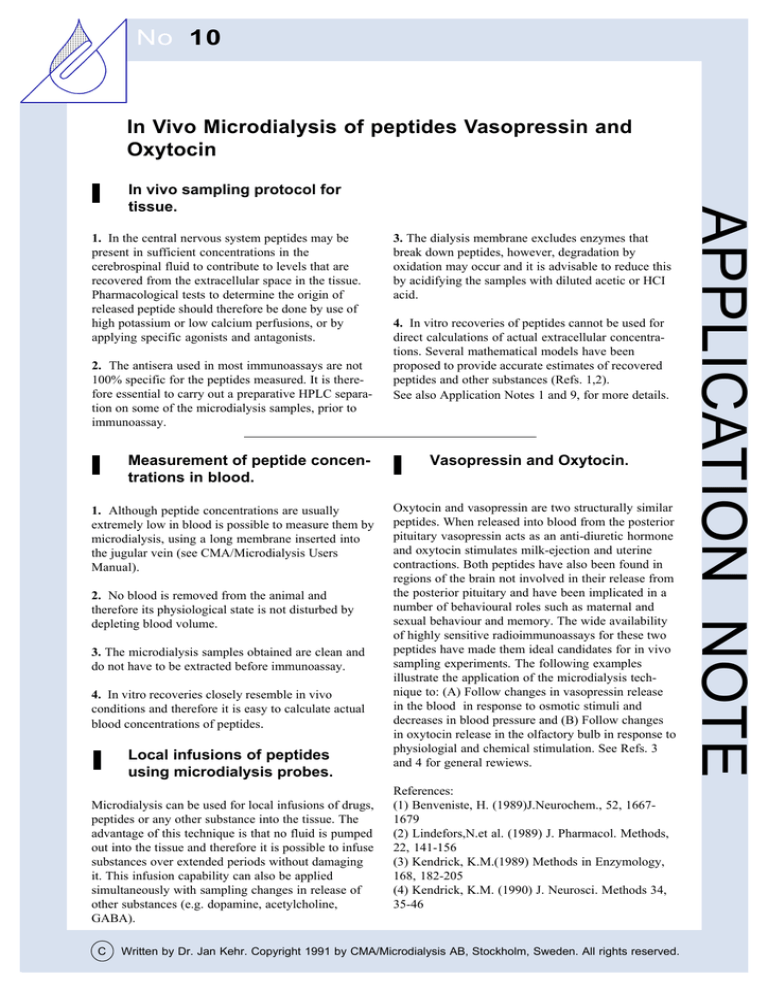APPLICA TION NOTE - CMA Microdialysis
advertisement

No 10 In Vivo Microdialysis of peptides Vasopressin and Oxytocin 1. In the central nervous system peptides may be present in sufficient concentrations in the cerebrospinal fluid to contribute to levels that are recovered from the extracellular space in the tissue. Pharmacological tests to determine the origin of released peptide should therefore be done by use of high potassium or low calcium perfusions, or by applying specific agonists and antagonists. 2. The antisera used in most immunoassays are not 100% specific for the peptides measured. It is therefore essential to carry out a preparative HPLC separation on some of the microdialysis samples, prior to immunoassay. Measurement of peptide concentrations in blood. 1. Although peptide concentrations are usually extremely low in blood is possible to measure them by microdialysis, using a long membrane inserted into the jugular vein (see CMA/Microdialysis Users Manual). 2. No blood is removed from the animal and therefore its physiological state is not disturbed by depleting blood volume. 3. The microdialysis samples obtained are clean and do not have to be extracted before immunoassay. 4. In vitro recoveries closely resemble in vivo conditions and therefore it is easy to calculate actual blood concentrations of peptides. Local infusions of peptides using microdialysis probes. Microdialysis can be used for local infusions of drugs, peptides or any other substance into the tissue. The advantage of this technique is that no fluid is pumped out into the tissue and therefore it is possible to infuse substances over extended periods without damaging it. This infusion capability can also be applied simultaneously with sampling changes in release of other substances (e.g. dopamine, acetylcholine, GABA). C 3. The dialysis membrane excludes enzymes that break down peptides, however, degradation by oxidation may occur and it is advisable to reduce this by acidifying the samples with diluted acetic or HCI acid. 4. In vitro recoveries of peptides cannot be used for direct calculations of actual extracellular concentrations. Several mathematical models have been proposed to provide accurate estimates of recovered peptides and other substances (Refs. 1,2). See also Application Notes 1 and 9, for more details. Vasopressin and Oxytocin. Oxytocin and vasopressin are two structurally similar peptides. When released into blood from the posterior pituitary vasopressin acts as an anti-diuretic hormone and oxytocin stimulates milk-ejection and uterine contractions. Both peptides have also been found in regions of the brain not involved in their release from the posterior pituitary and have been implicated in a number of behavioural roles such as maternal and sexual behaviour and memory. The wide availability of highly sensitive radioimmunoassays for these two peptides have made them ideal candidates for in vivo sampling experiments. The following examples illustrate the application of the microdialysis technique to: (A) Follow changes in vasopressin release in the blood in response to osmotic stimuli and decreases in blood pressure and (B) Follow changes in oxytocin release in the olfactory bulb in response to physiologial and chemical stimulation. See Refs. 3 and 4 for general rewiews. References: (1) Benveniste, H. (1989)J.Neurochem., 52, 16671679 (2) Lindefors,N.et al. (1989) J. Pharmacol. Methods, 22, 141-156 (3) Kendrick, K.M.(1989) Methods in Enzymology, 168, 182-205 (4) Kendrick, K.M. (1990) J. Neurosci. Methods 34, 35-46 Written by Dr. Jan Kehr. Copyright 1991 by CMA/Microdialysis AB, Stockholm, Sweden. All rights reserved. APPLICATION NOTE In vivo sampling protocol for tissue. Vasopressin concentrations in dialysate (pg/ml) A 60 40 20 3 ml haemorrhage 1.5 mMol NaCI i.p. 0 0 1 2 3 4 TIME (h) 5 6 7 B Mean oxytocin concentration pg/ml Mean oxytocin concentration pg/ml Fig. 1. Microdialysis measurment of vasopressin in rat blood 100 * 50 0 12345 12345 12345 12345 12345 12345 12345 12345 12345 12345 12345 12345 12345 12345 12345 BEFORE DURING AFTER 200 100 0 ** 1234 1234 * * 1234 123412345 1234 123412345 12345 1234 12345 1234 123412345 12345 123412345 1234 123412345 12345 1234 12345 1234 123412345 12345 1234 123412345 12345 1234 123412345 12345 123412345 1234 123412345 12345 300 mM KCI VAGINOCERVICAL STIMULATION Fig. 2. Oxytocin release in sheep olfactory bulb (Material in this application note kindly provided by Dr K.M. Kendrick, Institite for Animal Physiology and General Research, Cambridge U.K.) If you require further details on Microdialysis procedures, HPLC analysis, instrumentation or bibliography, please do not hesitate to contact: Box 2 • 171 18, Solna Tel 08-470 10 00 • Fax 08-470 10 50 73 Princeton Street, North Chelmsford • MA 01863 • USA Tel: +1 (978) 251-1940, (800) 440-4980, Fax: +1 (978) 251-1950 February 1994 www.microdialysis.com


